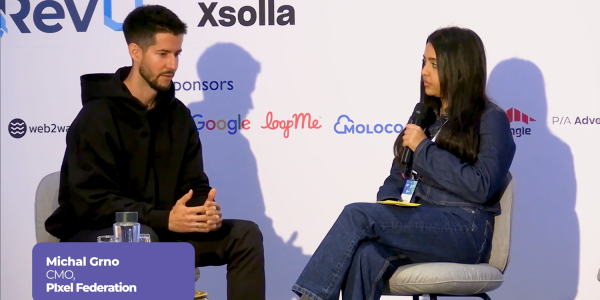From Mobile to the Big Screen: Why Gaming Apps Are Winning on CTV

The shift from mobile to CTV isn’t just another industry trend — it’s a moment of convergence that mobile gaming and app developers are uniquely prepared to capitalise on. Over the past decade, mobile technology has significantly shaped how people play, engage with, and interact with content. Now, those same behaviours are finding a natural home on the biggest screen in the house.
In my work across partners, advertisers, developers, and DSPs, I’ve watched this shift accelerate. The opportunity isn’t simply “more screens”; it’s that CTV is maturing into a performance-capable, engagement-rich environment — one where mobile-native companies have the strongest competitive edge.
Below are the key reasons why gaming apps are not just entering CTV… they’re winning on it.
1. Screen behaviours are converging — and gaming apps already understand engagement
CTV used to be the classic lean-back channel. But viewer behaviour is changing fast:
- People stream, browse, and interact across multiple screens at once.
- Smart TVs and streaming devices are now app ecosystems, not passive broadcast endpoints.
- Viewers expect personalisation, choice, and interactivity everywhere — even in the living room.
This means the TV experience is becoming app-like, and no industry understands engagement loops, UX efficiency, and retention better than mobile gaming.
What works on mobile — intuitive flow, lightweight onboarding, rewards, micro-sessions — translates beautifully to the big screen when adapted well.
Games have already mastered the psychology of keeping users active. CTV is simply becoming the next canvas.
2. Mobile gaming has perfected ad-driven monetisation — an advantage CTV desperately needs
Mobile gaming built — and scaled — entire businesses on ad-supported models. Rewarded video, interstitials, playable experiences, dynamic formats… these are refined systems. Developers know how to balance engagement, monetisation, and user experience.
Contrast that with CTV, where monetisation has historically been:
- Heavily linear-inspired
- Non-interactive
- Lacking real-time optimisation
- Dominated by standard video formats
That’s changing. Quickly.
As highlighted in Gamesforum’s coverage of Duolingo’s ad strategy shift, owning more of the ad experience and leveraging first-party behaviour data opens new monetisation frontiers. Mobile apps already live in that world. CTV needs new ad thinking — and mobile being the most mature ad-driven ecosystem is ready to lead it.
When CTV becomes more interactive, more measurable, and more performance-friendly, who benefits first? The companies that are trained in mobile ad economics.
3. Mobile teams have a performance mindset — and CTV is shifting in that direction
In conversations with UA leaders, DSP partners, and app advertisers, one theme is universal: they want performance signals on CTV. Historically, that was difficult. But the gap is closing thanks to:
- Better cross-device attribution
- Household graph improvements
- Interactive CTV formats
- More granular reporting & identity signals
In the Gamesforum feature with BLKBOX.ai’s CEO, the problem of creative overload and ROAS erosion is front and center. Mobile teams know this struggle intimately — and they’ve developed sophisticated creative testing systems to solve it. Those same systems are now being adapted for CTV, where creative variety, pacing, and format experimentation are still underdeveloped.
Mobile teams don’t just “advertise”. They optimise. They test. They scale. CTV is finally becoming a space where those skills translate.
4. Cross-screen journeys build higher LTV, and CTV unlocks a new layer of retention
The beauty of adding CTV to a mobile product strategy is that it doesn’t replace mobile — it enhances it.
Imagine:
- A user plays a puzzle game on mobile during the day.
- In the evening, they relax in front of a streaming platform and continue on the big screen.
- Their account syncs seamlessly.
- Their rewards, streaks, or progress transfer across devices.
This deepens engagement, boosts retention, increases brand perception, and ultimately raises LTV.
Mobile developers have never had a better opportunity to extend the user journey.
And advertisers love it. Big screens deliver premium storytelling. Mobile delivers action and conversions.
Together, they create a full-funnel environment with measurable outcomes.
5. Brand budgets are entering the chat — and gaming apps finally get a seat at the big-screen table
CTV attracts brand advertisers who historically never looked at mobile performance inventory. This is a massive opportunity for gaming and consumer apps.
Why?
Because on CTV, these apps can showcase:
- High-impact creative
- Story-driven ads
- Premium placements
- Contextual relevance
- A living-room audience mindset
Traditionally, mobile was seen as “performance only”. CTV breaks that ceiling. It allows apps to tap into brand budgets while still driving measurable outcomes when users shift back to mobile.
For partnerships and sales teams — including ours — this opens entirely new deal structures and cross-screen collaboration models.
6. Mobile gaming’s innovation culture is exactly what CTV needs right now
The best mobile teams iterate constantly:
- New creatives weekly
- Rapid A/B testing
- Timing and frequency optimisation
- User segmentation
- Dynamic reward balancing
CTV has lacked this level of sophistication — until now.
With AI-enhanced creative workflows (as explored in Gamesforum’s article on scaling creativity), segmentation tools, and new measurement partners, CTV is starting to support the same experimentation culture that made mobile thrive.
Mobile studios enter this space with a decade-long head start.
Real-world example: The big-screen edition boosts everything
To illustrate, imagine a midcore strategy game with millions of daily mobile users. By adding a CTV experience — even one that is partially interactive or companion-style — the studio can:
- Extend session duration
- Open premium ad inventory
- Boost brand trust
- Reengage churned users via TV placement
- Encourage mobile installs through cross-screen rewards
- Appeal to co-viewing households (parents + kids, couples, roommates)
The result is a 360° experience that mobile alone can’t offer.
This is the kind of thinking partners and advertisers are becoming excited about — and where we see clear momentum.
Final Thoughts: Mobile apps are not entering CTV… they’re defining its future
For gaming apps, this moment isn’t experimental — it’s strategic.
The big screen is no longer “TV advertising”. It’s an extension of the mobile ecosystem.
Those who move early will build:
- Stronger retention loops
- Higher LTV
- Premium monetisation
- Cross-screen loyalty
- New partnership models
- Differentiated brand experiences
And from my conversations across the industry, one thing is very clear: the companies that built their empires in mobile are the ones best positioned to dominate CTV.
The next wave of app growth will be won not on mobile alone, but across screens — and the living room is the next frontier.











